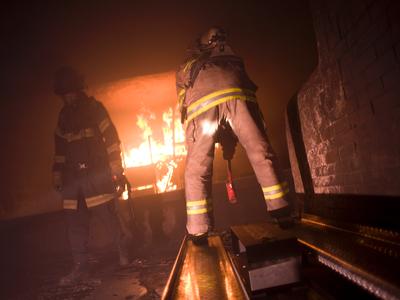Cardiovascular and Biomechanical Responses to Firefighting and PPE
Summary
Funding provided by: Department of Homeland Security, United States Fire Administration - Assistance to Firefighters Grant Program: Fire Prevention and Safety Grant
As firefighter's are well aware, one of the leading causes of line of duty death in the fire service is from heart attacks; and one of the leading causes of firefighter injuries are slips, trips and falls. While the origins of heart attacks and slips, trips and falls may appear unrelated, previous research suggests that heat stress may be a common causal factor in both. Furthermore, one critical factor that has promise to mitigate both of these injuries and fatalities is improvements in personal protective equipment. Previous research at the Illinois Fire Service Institute (IFSI) has documented that PPE configuration can impact physiological and performance variables. Thus, redesigning PPE to reduce heat stress and mitigate cardiovascular disruptions and biomechanical changes may positively affect both the leading cause of firefighter fatalities and injuries.
This study documented laboratory based cardiovascular risk factors among a large cohort of firefighters and investigated the effects of different PPE configurations on physiological and biomechanical responses to live fire firefighting activities. Participants engaged in 18 minutes of firefighting activity in a burn tower that contained live fire. Firefighting activities included repeated work-rest cycles, with firefighters climbing stairs, conducting forcible entry, search and rescue, and a simulated hose pull.
While the study outcomes were wide ranging, this was one of the most complete descriptions of the physiological stress of firefighting at the time – finding that simulated firefighting activity lasting 18 minutes causes significant physiological disruption in heart rate and core temperature. The simulated firefighting activities caused a significant increase in platelet numbers and a significant increase of platelet activation (resulting in faster clot formation). Firefighting activity resulted in an increased level of coagulation and significant changes in clot breakdown. PPE configuration did not significantly affect physiological, perceptual, blood chemistry, or coagulatory responses to firefighting activity. However, donning of firefighting personal protective equipment caused significant detriments in gait and balance parameters regardless of which configuration of PPE was worn. Simulated firefighting activity had negligible further effects on gait and balance parameters compared with the effect of donning firefighting PPE.
Related Projects
- Cardiovascular Function Following Prolonged Firefighting
- Effect of Aspirin on Hemostatic and Vascular Function after Live Firefighting
- Impact of SCBA Design & Fatigue on Balance, Gait and Safety of Movement
- Science, Medicine, Research, Technology for Emergency Responders (SMARTER) - Skidmore College lead
- Firefighting and On-Scene Rehabilitation on Homeostasis
Images
Files
| Fire Service Reports |
| Firefighter Fatalities and Injuries. The role of Heat Stress and PPE |


